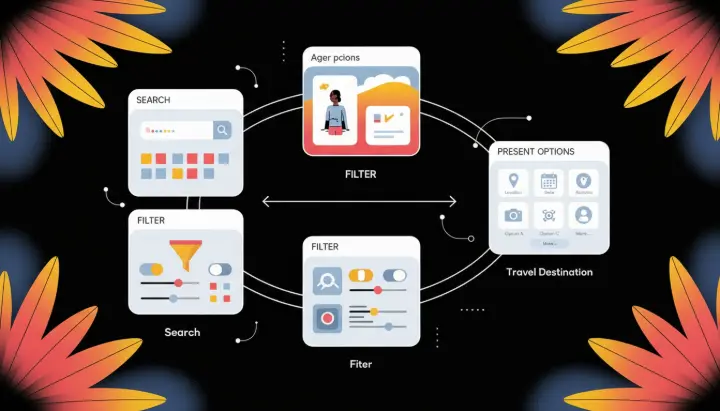The conversation around artificial intelligence has largely centered on generative AI, the technology that powers tools like ChatGPT to create text, images, and code. While impressive, these systems are often reactive, waiting for a human prompt to act. A new, more powerful paradigm is emerging, agentic AI.
This new wave of AI isn’t just about generation, it's about autonomous action. It's an AI that can perceive its environment, set goals, plan a course of action, and execute it, all with minimal human oversight.
But what does it take to build such a system? The shift from reactive generative models to proactive, autonomous agents requires a fundamental evolution in how we think about AI architecture.
This is the realm of agentic AI infrastructure, a complex, multi-layered framework designed to give AI systems the 'brains' they need to operate in the real world.
The Core Components of an Agentic System
At its heart, agentic AI infrastructure is a sophisticated assembly of interconnected components. Think of it like a human nervous system, with different parts responsible for different functions.
The system starts with Perception, which is the agent’s "sensory system." It's how the AI gathers information from its environment. This can include data from APIs, web search results, sensor data (for a robot), or even simple text from a user. This data is the raw input that allows the agent to understand its current state and the world around it.
For an agent to be truly autonomous, it also needs Memory. It can't just operate in the present moment. It needs to remember past experiences, user preferences, and learned knowledge.
This is managed by a memory system, typically split into two types. Short-term memory, or Working Memory, holds the context of the current task, like a conversation history. It's crucial for maintaining coherence during a single, complex workflow. Long-term memory stores persistent knowledge, often using a vector database.
It allows the agent to recall information from a vast knowledge base or past interactions to inform its decisions.
The cognitive core of the system is Reasoning and Planning, where the agent makes decisions. Powered by a Large Language Model (LLM), this layer processes the information from perception and memory.
It's here that the agent breaks down a complex goal into smaller, manageable steps. This process often involves techniques like Chain-of-Thought and Goal Decomposition.
The final component is Action and Execution, where the agent actually performs the tasks. Once the agent has planned its actions, this layer executes them. This is often done by giving the agent access to a set of tools, such as APIs, a code interpreter, a search engine, or any external service. This allows the agent to interact with the world beyond its internal logic, whether it’s sending an email, booking a flight, or running a data analysis script.

The Workflow of an Agent
So, how do these components work together? Imagine you ask an agentic AI to "plan a weekend trip to a beach city in California for two people in September, and find a hotel with good reviews."
First, the agent uses its Perception to receive your request and identify key information: location ("beach city in California"), duration ("weekend"), time ("September"), and the goal ("find a hotel with good reviews"). It also recognizes that it needs to interact with external tools.
Next, the Reasoning and Planning layer takes over. The LLM formulates a plan. It will first search for popular beach cities in California, then check the weather in those cities for September. After that, it will find available hotels in a selected city for a September weekend, and then filter the hotels based on user ratings. Finally, it will present the options to the user.
For Action and Execution, the agent starts executing its plan, step by step, by using its available tools. It might use a web search tool to find cities, a weather API to check forecasts, and a hotel booking API to find and filter accommodations.
As it receives results, its perception and reasoning layers update its plan, and it may even correct mistakes on the fly. For example, if a city is fully booked, it will go back and search for another.
Over time, with more feedback and experiences, the agent can use Learning and Adaptation to optimize its process. It might discover a more efficient way to search for hotels or learn a user's preference for certain amenities, incorporating this new knowledge into its long-term memory for future tasks.

The Road Ahead: Challenges and Opportunities
While the potential of agentic AI is enormous, from automating supply chains to revolutionizing customer service, its development is not without challenges. Because agentic systems have a degree of autonomy, their behavior can be less predictable than traditional software.
Ensuring they consistently perform as expected, especially in high-stakes environments, is a major hurdle.
Agents often have access to a wide range of systems and data, raising significant security concerns.
A poorly designed agent could potentially leak sensitive information or be vulnerable to a prompt injection attack, where a malicious prompt tricks the agent into performing an unauthorized action.
Giving an AI a high degree of autonomy also necessitates robust ethical guardrails. We need to design systems that are transparent, accountable, and aligned with human values to prevent goal misalignment and unintended consequences.
As we move towards more complex systems, the ability for multiple agents to collaborate on a single task becomes crucial. This requires sophisticated frameworks for communication and coordination to avoid conflicts and ensure efficiency.

Conclusion
Despite these challenges, the future of agentic AI is incredibly promising. It's a technology that is poised to move AI from a helpful assistant to a true partner, capable of tackling complex, multi-step problems and driving a new era of automation and innovation.
The infrastructure we build today will be the foundation for the autonomous systems of tomorrow, transforming industries and reshaping the way we work and live.